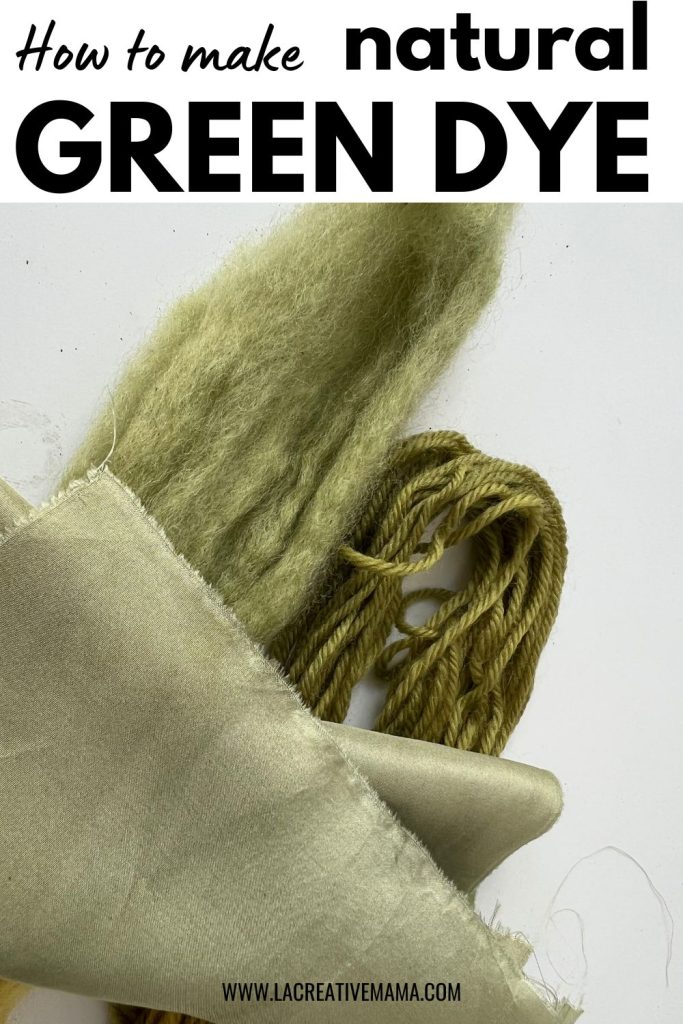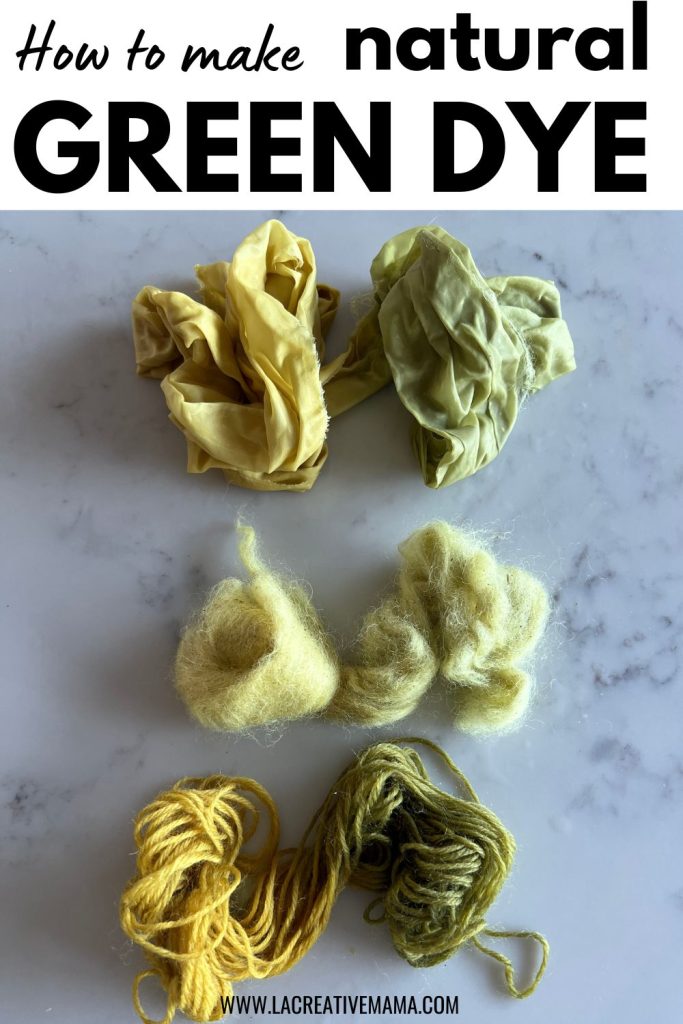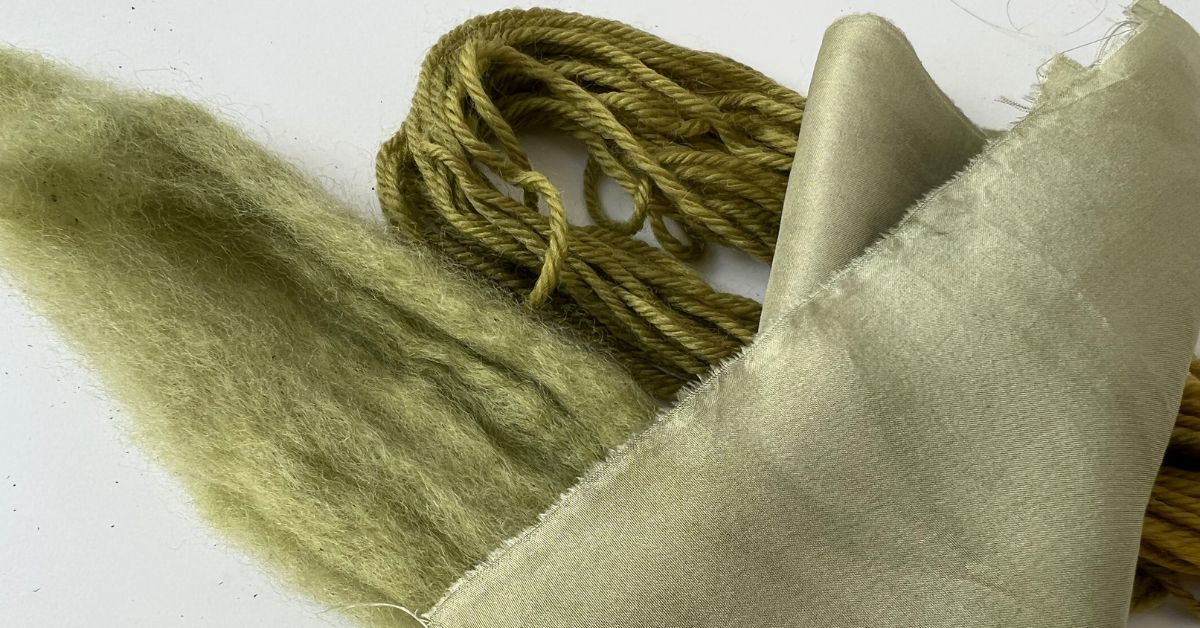Hi Creative Mamas! I have discovered how to make natural green dye using yerba mate tea. This is another great post about natural dyeing 🙂
Mate is a very common tea that we drink in Argentina, I grew up drinking it and it’s a bit of a ceremony. It’s served in these little vessels called mate which are made out of wood or pumpkin and we drink it through a straw “bombilla”.

A couple of weeks ago I was chatting with a fellow natural dyer from Argentina, and she told me that she was getting beautiful natural green dye from extracting color from mate.
So of course I had to give it a go! Natural green color is hard to get. It’s not as easy as extracting color from green plants or food scraps and vegetable dyes which are green.
Usually I would dye my fabric or yarn using natural dyes such as fusticwood or dyers chamomile and then immersing it inside an indigo bath.

However, this is a very laborious process since the indigo vat needs to be done from scratch and it needs a warm temperature to thrive and to survive. So I was very keen to give mate a go!
What follows is a step by step tutorial on how to get natural green dye using yerba mate as your natural dye. As you will see I needed the assist of iron water to get to the green I wanted but it is a very easy step that ads a few more minutes to the whole process.
How to make natural green dye tutorial
If you are a beginner natural dyer make sure to read the Ultimate Natural Dyeing Guide and the Beginners Guide to Natural Dyes.
Materials and equipment
This post contains affiliate links, which means I receive a small commission, at no extra cost to you, if you make a purchase using this link. Please see my disclosure for more details.
- Stainless steep pot
- Mordanted natural fibers (I am using silk fabric, wool roving and wool yarn)
- Wooden spoon
- Strainer
- Mate tea (also called yerba mate)
- Alum
- Iron powder (ferrous sulphate)
How to make a dye bath with mate
The first step is to gather all your materials. Make sure that you have a stainless steel pot to work with and remember that all utensils used in natural dyeing can never be used for cooking ever again.
For this tutorial I used 300% WOF (weight of fiber). I wanted to make sure that I was going to get a strong color result but after having experimented with using mate as a natural dye I am comfortable using a ratio of 200% WOF as well.
Feel free to try different dye/fiber weight ratios or follow my suggestions as explained in the natural dyeing guide.

Weigh your fibers and weigh the mate. Place the mate inside a stainless steel pot and fill with cool water.

Mate is super absorbent so be sure to add plenty of liquid to the pot.

Stir well and place on the stove top. Bring to a low boil and then reduce heat to a simmer.
Simmer for 1 hour. This is the extraction stage and the photo below illustrates how the dye bath will look after 40 minutes of simmering.

After 1 hour of simmering, remove the dye bath from the heat. Let it cool for a while until all the liquid has settled and there are no more bubbles.

Strain the mate liquid and place the dye liquid inside another stainless steel dye pot.

Press the mate against the strainer with your wooden spoon to release all the liquid.
You can dispose of the mate by placing it in your compost or onto the garden. I use it as fertilizer for my dye garden.

DIY Natural color with mate
Grab your mordanted fabrics or yarns. For this tutorial I am using animal fibers such as merino wool yarn, a piece of silk and wool roving which have been mordanted in an alum bath.
You can also use cellulose fibers but make sure you mordant accordingly.
Please note that the fibers need to also be scoured correctly (cleaned) so be sure to follow the instructions here.

Place the fibers inside the dye liquid.
At this stage I saw the fibers turn into a soft green dye straight away!

Make sure there is enough water so the fibers can move around freely inside the dye bath.

Bring the dye pot to a simmer and simmer for 1 hour.


After 1 hour of simmering, remove the pot from the heat and check the color.
At this stage I felt that the initial soft green color had turned into a bright yellow dye color.

However, I could see the green hues coming through as well.

Determined to get the dark green which my colleague showed me she was getting, I removed my fibers from the dye liquid and I added 1% WOF of ferrous sulphate (iron powder).
You can also add iron water instead of iron powder.
The water immediately turned dark. I placed the fibers inside the pot again and left them there for 5 minutes.

I wanted to keep a record of the before and after effect of using the iron modifier so I only immersed half of the fiber inside the modified dye liquid.


The photo below shows the results after 5 minutes of immersing the fibers inside the iron modified liquid.
As you can see I got a darker green color from all 3 types of fibers straight away.

I got vibrant color from using mate as my plant dye.
There are a few things that I want to try in the dyeing process to keep researching this amazing new natural dye and to test whether I can get more intense color.
These are:
- Different ratios of natural dye and fiber weights
- Different dyeing times
- Mixing mate dye with other food dyes such as avocado skins dyes, red onion skins and yellow onion skins dye.
- Using mate dye in combination with eco printing techniques.

I hope you have enjoyed this tutorial and that you are as excited as I am for discovering an easy way to get natural green dye color!
You can keep the left over natural dye bath inside a glass jar for later use.



Thank you!
Green is my favorite color and this past year and into this year, I am on a mission to see how many different greens I can get from my yellow dyes in my dye closet. I have a bunch already.
Just tried this process. My colour was so pale. Probably did not use enough of the mate tea? Will have to overdye and try again.
Hey Kathleen, thanks for sharing. How did you heat set it? Also did you not mordant it with alum?
Will the Baking Soda stabilise the colour once if it is post modified with it?
If it is Alkaline won’t it change again if washed in non alkaline water?
hi, I’m new here. will start using and making g these dyes soon. I will have to see whether some of the products are available here in the UK. I’m excited about this as I’ve not been successful before. I love researching and developing stuff.
Hi Barbara,
that’s great! So the main thing is to use dyes that are proven to be great performers and to apply the mordants according to the fiber composition! Hope this helps!